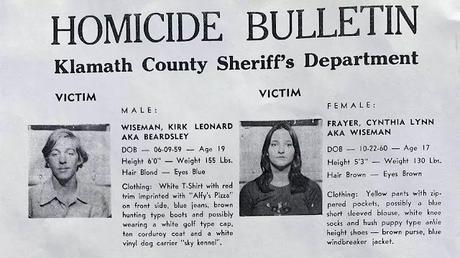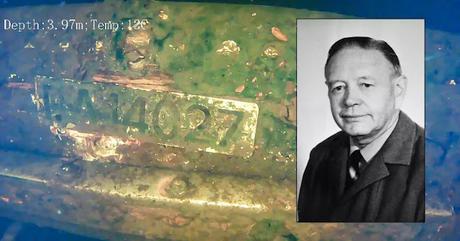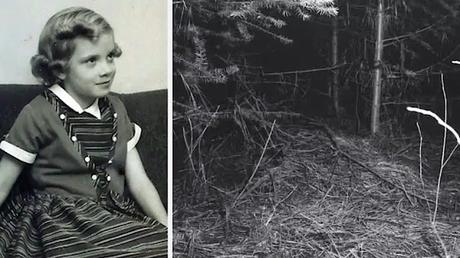Kirk Leonard Wiseman and Cynthia Lynn Frayer

pic credit: Google Images
On November 17, 1978, the remains of two teenagers; a male and a female were found by a man cutting firewood near Lake of the Woods and the Dead Indian Highway in Klamath County, Oregon. Horrified, the man called the police. Remains of a small dog were also found at the crime scene.
An autopsy revealed both victims had been shot multiple times in the head with a .22 caliber gun. The female victim had been sexually assaulted. The teenagers were later identified as Kirk Leonard Wiseman, 19, and Cynthia Lynn Frayer, 17.
Both victims did not reside in Klamath County and had no connection to the area beside a hitchhiking sign that said, KFalls that was found at the crime scene. Crime scene evidence was collected, preserved, and stored in hopes that advancements in technology would be able to help find the killer.
Police found a letter by Cynthia addressed to her parents at the crime scene. In the letter, she talked about her travel plans as well as her hopes and dreams. Police believe the pair were hitchhiking through Washington state and Oregon along with their dog.
They most likely had planned to go to Crater Lake as it is a place that Cynthia always wanted to visit. Police later determined the pair had stayed a night at a motel in Roseburg. They were then picked up by a person who claimed to have dropped them off at a Grants Pass restaurant.
Over the years, police interviewed several suspects but none were ever charged and the case grew cold and stayed that way for nearly 40 years. Then, in 2018, investigators sent pieces of Cynthia’s clothing and items found at the crime scene to the Oregon State Police Crime Lab in Bend. And in 2019, investigators found evidence of traces of Unknown male DNA on Cynthia’s clothing.
The Unknown male DNA was then entered into the CODIS database but no matches could be found. Investigators then decided to utilize the expertise of Virginia-based forensic service Parabon NanoLabs. The unknown male DNA was entered into Genealogy websites and Soon, in the summer of 2021, they were able to find a potential match.
Investigators then contacted the suspect's family but learned that the suspect had died in 1996. His children agreed to provide a DNA sample and it was later confirmed that the DNA found at the crime scene belonged to their father, Ray Whitson Jr.
Whitson lived with his family in Klamath Falls from 1976 and 1982 and worked at a lumber mill. Whitson had a prior criminal record. He was known to frequent the area where the two bodies were found.
And His family members also confirmed that Whitson had owned a .22 caliber gun, similar to the one used in the murders. While the suspect's demise made it impossible to prosecute him for his heinous crimes, having some closure as to the identity of their loved one's killer may give some semblance of closure to two grieving families who waited more than four decades for answers.
William Anker Lie

William Anker Lie was born on October 19, 1910, in the US. He stayed in the US until he was 5 years old before his mother moved to Norway in 1916. He spent his childhood, teenage and adult years in Oslo (previously known as Kristinia).
During his teenage years, he developed an interest in Agriculture and later started his own wholesale business of fruits and vegetables. After William had a stroke in 1969, he became depressed and changed his behavior.
He also started phasing out his business. On 13 July 1972, William and his wife Ragnhild were visiting relatives on Opsund farm in Ski. They were going to stay there for a few days to help the relatives with the farm operations.
That night, while the family was eating dinner, William got up from the table and left the farm. Ragnhild asked him where he was going, but William did not reply. This would be the last time William was seen alive. Later that night when William had still not returned, Ragnhild called her apartment home in Oslo hoping William had gone there.
The phone rang for a bit before someone picked up the call. However, they did not say anything and remained quiet until Ragnhild asked if it was William on the other end. William then said yes. Ragnhild asked him when he would be returning to Ski.
William replied that he wasn't feeling well and was not in the condition to drive as he had just taken some tablets. The call ended and Ragnhild assumed William would return the next day. However, he never did. When William had still not returned after 2 days, Ragnhild and William's brother went to the Oslo apartment.
However, William was nowhere to be seen. Strangely, Ragnhild's clothes and paintings were carefully cut up and placed on the coffee table in the living room. William was then reported missing. A search investigation was launched and Missing person flyers were distributed throughout the police stations in Norway.
William's car, a white Vauxhall Cresta, with the license plate number DA 14027 was also missing. Ragnhild told investigators that along with the car, camping equipment including folding tables, folding chairs and a few more items that were kept in the garage were missing.
In the next few days, William's information was published in the newspapers and media but to no avail. A month later, an investigating officer was reading the newspaper when a report caught his eye that mentioned that someone had found abandoned camping equipment near the lake Trytetjern in Nesbyen.
The investigator contacted the Nesbyen police station, who sent him the list of all the items that were found near the lake. The list included a travel radio, a small outdoor table, a travel briefcase, camping chairs, a water jug, a yellow warning light, a coffee pot, a jar of strawberry jam with handwritten words "Strawberry 1971", and a cover for the propane stove.
The travel radio still had a sticker on it from the l Electronic store it was purchased from in Oslo. The police contacted the store who told them that they had sold the radio to one William Anker Lie. Ragnhild was called in and she was able to identify most of the items including the Jamjar which she said she herself had labeled with the words "Strawberry 1971."
The Police then interviewed the man who found the abandoned camping equipment and the items near the lake. He told the police that he and his wife were traveling to Vassfaret around 10-11 am when they noticed a man sitting in his chair near the lake.
They noticed he had a camping table with a tablecloth and thermos next to him. Later that evening, while returning back to their home and passing through Trytetjern, they could not find the man anywhere however his camping equipment was still present. Finding the abandoned camping scene suspicious, they notified police.
In the next few days, police would receive another tip from a business associate of William who claimed to have seen William somewhere along the road between Hedalen and Nesbyen. He said he had been wearing a blue coat. William's family confirmed that William did have a blue coat that he kept in his car.
He used to wear the coat if he needed to wash or polish his car. The police then extensively searched the area but could not find any trace of William or his car. The police, however, did not search Lake Trytetjern stating that the car could not have ended up in the water as it is too shallow to hide a car.
With no leads, the search was soon stopped. In 1974, William was declared dead by a court and the case grew cold. In 2019, Åsted Norge, a detective show in Norway began investigating the case. In the autumn of 2021, they decided to check lake Trytetjern as that was the only place during the earlier investigation that had not been searched.
A search of the lake was conducted using sonar and an underwater drone. Soon, an object was picked up by the sonar at around 10 meters underwater. The drone was then used to investigate and on September 10, 2021, a car with the license plate number DA 14027 was located, laying vertically with the front part down into the mud of the seabed.
They notified police and the car was pulled out and examined. As the car was buried into the seabed in the front, the paint was preserved and stayed as it had looked in 1972. The police found the remains of humans inside the car. The remains were then sent for an autopsy and identification to Oslo University Hospital.
A DNA later confirmed the remains to belong to William Anker Lie. Investigating the car, police found several objects inside the car. The objects were well preserved, despite the car being underwater for almost half a century.
The objects included a farewell letter, a signed letter of resignation, and a few other documents. Because the objects were wrapped in plastic they stayed well preserved throughout the years. William's wife and his brother died without knowing what happened to William.
William's immediate family was contacted and they want to bury his body in his hometown of Oslo. From the contents that were found, it is believed that William committed suicide. The case was finally solved after 49 years.
Candice Elaine Rogers

Candice Elaine Rogers was a 9-year-old Holmes Elementary School student living with her mother in Spokane, Washington. On March 6, 1959, Candice was outselling mints for her Camp Fire Girl Scout troop in the neighborhood when she suddenly vanished. Later that evening, when Candice did not return home, her mother reported her missing.
A massive search ensued. Police officers along with volunteers and family members started searching in and around the neighborhood. Helicopters were also called in to search from above and sadly, during the search, one of the helicopters is crashed resulting in 3 causalities. 12 hours later, a police officer found six boxes of mints scattered near a bridge.
However, there was no sign of Candice. Police would receive more than 750 tips in the following days but none of them panned out. Her case was covered in the media and her mother appealed to anyone who could help them provide any info into her disappearance but to no avail.
Then, 16 days later, two hunters found Candice’s shoes while hunting groundhog in remote woods. They notified police and soon, a search of the area found the body of Candice. She was found 12 miles away from her home. She had been buried under a pile of pine needles and brush. Her legs had been tied together at the ankles with parts of her own slip.
An autopsy revealed she had been sexually assaulted and strangled to death with a piece of her own slip. Over the years, several people confessed to the murder of the child but none of them were credible.
Alfred Graves and James Howard Barnett were considered suspects but they committed suicide shortly after. The only prime suspect was Hugh Bion Morse. Morse was a convicted serial killer and had murdered 2 Spokane women in a killing spree between 1959 and 1961.
In 1955, he was charged for attempted molestation of 2 eight-year-old girls while they were selling Girl Scout Cookies in Fairfield, California. He was admitted to an Atascadero state hospital for therapy and released as "cured" in January 1957.
Morse admitted to killing 3 women but denied that he had anything to do with Candice's murder. In 2001, investigators were able to retrieve an unknown male’s DNA from Candice’s clothing. A DNA test ruled Morse out as a suspect. Police interviewed multiple suspects over the last 6 decades but none were ever charged.
In 2020, investigators asked a lab to build a DNA profile of the unknown male DNA found at the crime scene but they declined as the DNA was too degraded to work with. The investigators then reached out to a Texas-based company Othram who were able to build a DNA profile.
The DNA profile was entered into genealogy databases and investigators found 3 possible suspects. The suspects were all brothers but were already dead. Police learned only one of the brothers, John Reigh Hoff had children.
The police then contact Hoff’s daughter who agreed to provide a DNA sample. A DNA test revealed that it was 2.9 million times more likely that Hoff's daughter was a genealogical match to the DNA sample found at the crime scene.
Police then exhumed Hoff’s body and a DNA test subsequently identified John Reigh Hoff as the killer. John Reigh Hoff was 20 years old in 1959 and was never a suspect in Candice’s murder. Hoff was a troubled teenager and at the age of 16, he ran from a state boys’ training camp near Olympia.
Authorities captured Hoff and three other boys near Yakima. His troubles would continue even after he was married and had children. In 1970, Hoff committed suicide by shooting himself in the head.
In an eerie coincidence, police learned that Candice and Hoff were both buried in the same cemetery it was also discovered by investigators that's Hoff’s stepsister was Candice’s “big sister” in her Girl Scout Camp Fire group.
Hoff’s wife and daughter have since removed Hoff’s body from the cemetery to provide Candice’s family some privacy. The case was solved after 62 years with little peace afforded to anybody involved.

